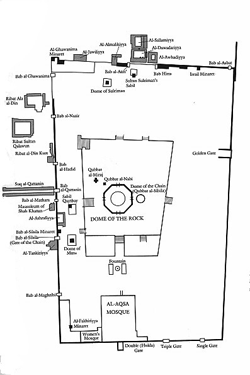The Temple Mount is the trapezoid-shaped, walled-in area in the southeastern corner of the Old City of Jerusalem. The four walls surrounding it date back – at least in their lower parts – to the time of the Second Jewish Temple, built at the end of first century B.C.E. These huge supporting walls, partly buried underground, were built around the summit of the eastern hill identified as Mount Moriah , the site traditionally viewed as the location of where Abraham offered his son Isaac as a sacrifice and the known location of the two Jewish Temples. The gaps between the walls and the mount were filled in to create a large surface area around the Temple. Its eastern wall and the eastern half of its southern wall form part of the city wall on those sides. Deep valleys (now partly filled by debris) run outside the walls (northeast, east, south, west), thus separating the Temple Mount from and elevating it above its surroundings, both inside and outside the city.The dimensions of the Temple Mount extend considerably beyond those given in the Mishnah (Mid. 2:1), which describes a square of approximately 250 × 250 m., referring only to the sanctified area within the Temple Mount as known today. The entire enclosure consists of an esplanade or courtyard, surrounding an elevated platform occupying approximately 23 dunams of land and decorated by arched structures around the Dome of the Rock. In each of the walls there are a number of gates. Some are ancient gates such as the Golden Gate which are blocked, and some are newer gates from the Arab conquest onward which are still in service.Within the area of the Temple Mount there are about 100 different structures from various periods, among them great works of art and craftsmanship, including open Muslim prayer spots, arches, arched porticos, Muslim religious schools, minarets, and fountains (some for drinking and others for worshipers to wash their hands and feet before prayer). Underneath the present-day surface, in the "artificial" parts of the mount, there are 34 cisterns. There are also other substructures, the largest of which is known as "Solomon's stables."
http://www.jewishvirtuallibrary.org/jsource/Society_&_Culture/geo/Mount.html

No comments:
Post a Comment